“], “filter”: { “nextExceptions”: “img, blockquote, div”, “nextContainsExceptions”: “img, blockquote, a.btn, a.o-button”} }”>
New perk: Easily find new routes and hidden gems, upcoming running events, and more near you. Your weekly Local Running Newsletter has everything you need to lace up!
>”,”name”:”in-content-cta”,”type”:”link”}}”>Subscribe today.
Your core is, quite literally, at the center of everything you do. It’s what powers your paddle strokes, allows you to reach for a climbing hold, and makes hoisting a heavy pack and carrying it over miles of technical terrain possible. It also helps you avoid injury during all those pursuits. But to make it work for you, you have to incorporate core exercises into your training plan.
What Exactly Is Your Core?
Often, core work focuses on building the vanity muscles of the six-pack (also known as the rectus abdominis) through crunches, which can overwork the hip flexors and lead to neck and lower back discomfort. A well-rounded core routine will target the entire core musculature, which also includes your diaphragm, pelvic floor, transverse abdominis (the deep core layer which provides postural stability), obliques, and some of your back muscles (erector spinae, multifidus).
While much of traditional core training involves exercises like planks (a static movement), you also need to train for dynamic stability. “Being in the outdoors is sometimes very unpredictable,” says Steph Gaudreau, a San Diego-based strength coach. Being able to engage your core during movement better prepares you to prevent falls or to catch yourself if you do fall.
That’s particularly important as you age and balance and stability become more challenging. Gaudreau notes that core strength training “can give you the confidence that you don’t have to start living a smaller life because you’re afraid of feeling less quick, less reactive, less strong.”
Building muscle memory through core strength training allows you to act faster in a potential injury situation. “The body is going to do what the body does, but the more practice we give it, the more it’s going to adapt,” says Gaudreau.
The Moves
Core work can be part of a warm-up, cool-down, or an active recovery day. Including it in a dynamic mobility warm-up can prepare your body for your workout. Single-leg Romanian deadlifts, for example, are great before a hike because they can “wake up your balance,” says Gaudreau. Suitcase carries can prime climbers for unilateral movements.
Instead of doing all these movements at once, choose three or four to group together, mixing different types of movements. A Pallof press, dumbbell windmill, and Russian twist will allow you to train your rotation and anti-rotation patterns while also working in multiple planes of motion.
Since your priority is likely your outdoor sport, start off slow with core training and add more reps or sets as you become more comfortable with these moves. “Anytime you start anything new, the thing that makes you sore is novelty,” says Gaudreau.
1. Side Plank with Rotation
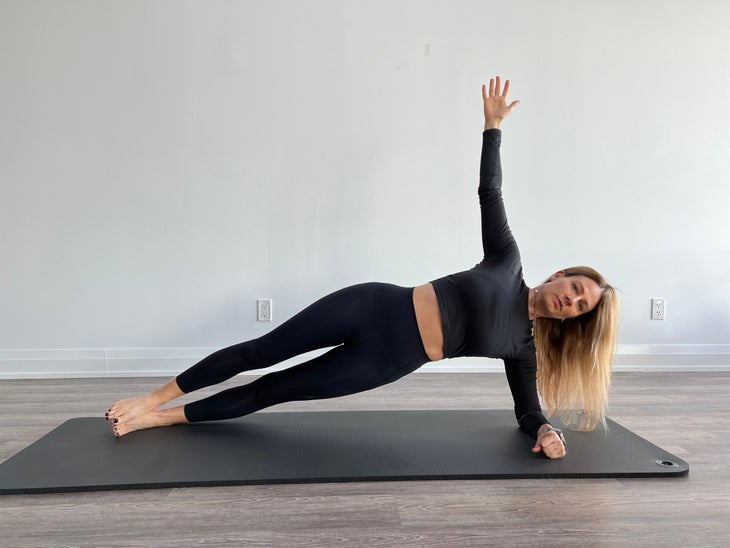
(Photo: Alyssa Ages)
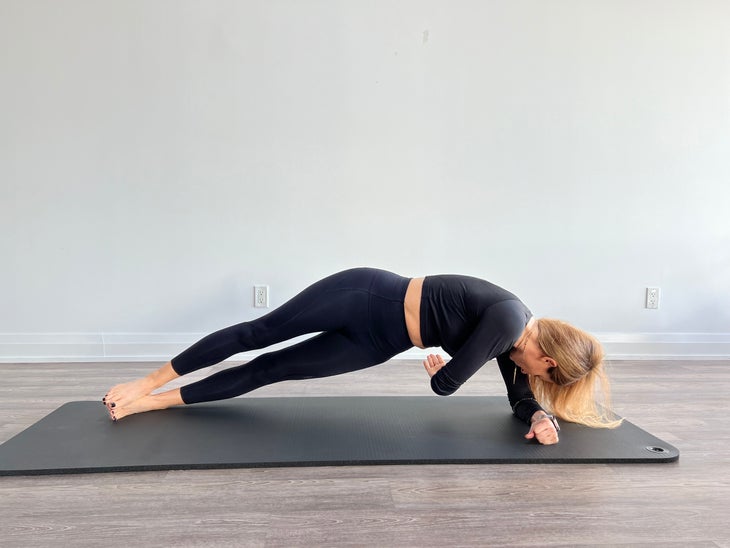
(Photo: Alyssa Ages)
What this move does: Improves balance; works the muscles in your hips, core, and shoulders; protects your spine
How to do it: Begin by lying on your right side, legs extended and stacked on top of one another. Prop your torso up on your right elbow, with your arm stacked directly under your shoulder, and palm flat on the mat. Inhale and engage your core, squeeze your glutes, and raise your hips and knees from the floor until your body is in a straight line.
Raise your left arm and exhale as you reach your left hand under your torso. Pause before bringing your left arm back to the starting position, keeping your hips elevated until you have completed all the repetitions. Move through a straight-arm plank to switch sides.
Volume: Two sets of 8 to 12 reps per side, with one minute of rest in between. As you progress, you can advance this movement and increase the following exercises to three sets.
2. Bird Dog
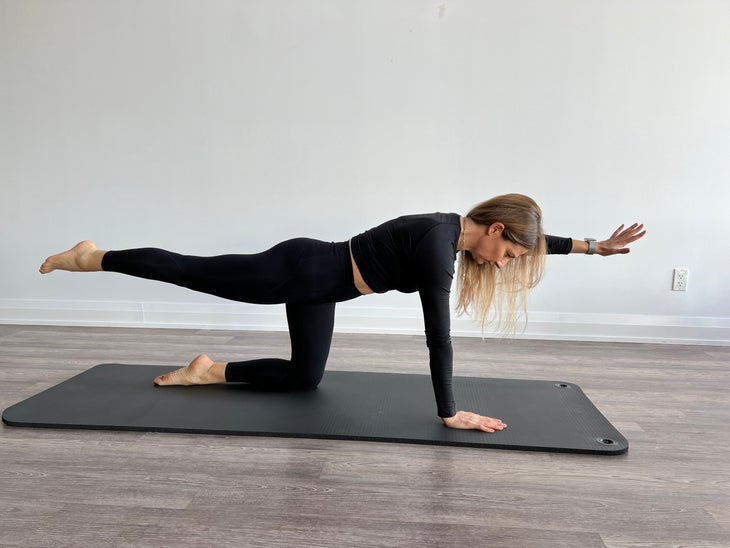
(Photo: Alyssa Ages)
What this move does: Works the core, shoulders, and glutes; challenges balance and stability; improves hip and shoulder mobility
How to do it: Begin on all fours with your hands directly under your shoulders and your knees under your hips. Maintain a neutral spine. Inhale to engage your core and exhale as you raise your right arm in front of you and left leg behind you until they are parallel to the floor, keeping both limbs straight. Slowly return to the starting position.
Keep your body from tilting or collapsing to one side to engage your core more efficiently. Repeat this movement for all repetitions on one side before switching sides.
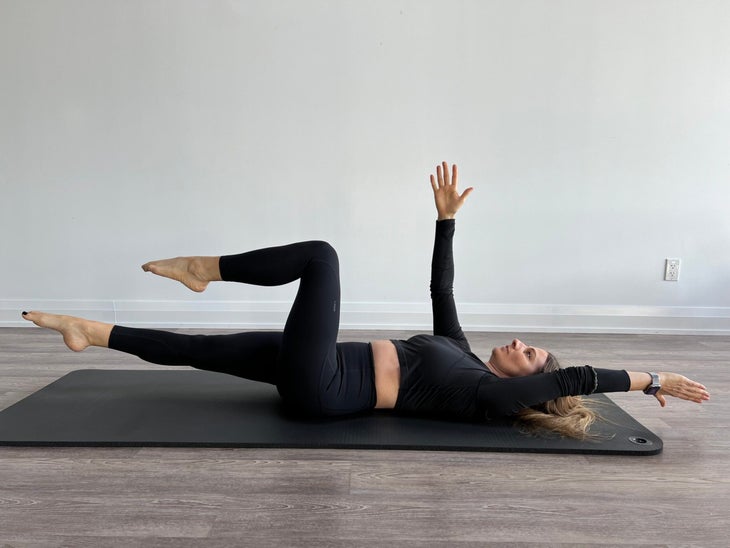
Modified version: If being on your knees is challenging, you can put a mat under your knees or perform a Dead Bug, which flips this movement upside-down. Lie on your back and raise your arms straight into the air, directly over your shoulders. Raise your legs with bent knees, keeping your knees directly above your hips. Engage your core and slowly lower your right arm toward the floor behind you and extend and lower your left leg toward the floor in front of you, hovering both limbs for a moment just above the floor. Return to the starting position and repeat this movement for all repetitions before switching sides.
Volume: Two sets of 8 to 12 reps per side, with one minute of rest in between.
3. Pallof Press
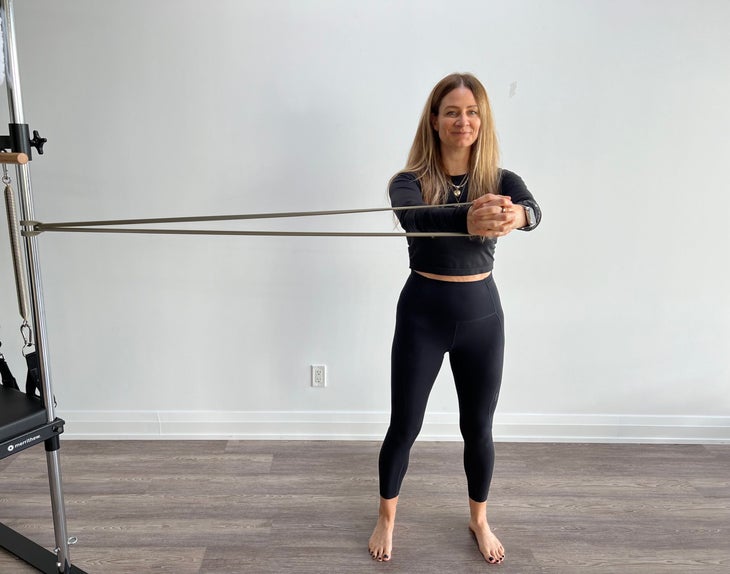
(Photo: Alyssa Ages)
What this move does: Works your deep stabilizer core muscles; challenges you to limit rotation of the spine while building core stability
How to do it: Attach a light resistance band to an anchor point (e.g., a rig at your gym or a door frame at home). Grip the other end of the band with a hand-over-hand grip and step away from the anchor point until there is no slack in the band. Standing with the right side of your body in line with the anchor point, hold the band at chest height with bent elbows. Exhale as you slowly press your arms out straight in front of you. Pause, then slowly return.
Repeat this movement for all repetitions before turning around so your left side is in line with the anchor point. The goal is to avoid any twisting in your torso. If you find your body twisting, step a little closer to the anchor point to lighten the load.
Volume: Two sets of 8 to 12 reps per side, with one minute of rest in between.
4. Resistance Band Roll-Down/Roll-Up
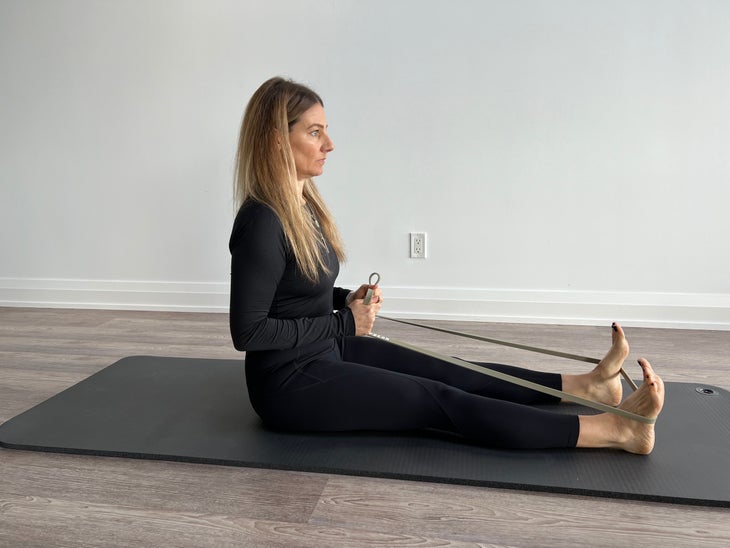
(Photo: Alyssa Ages)
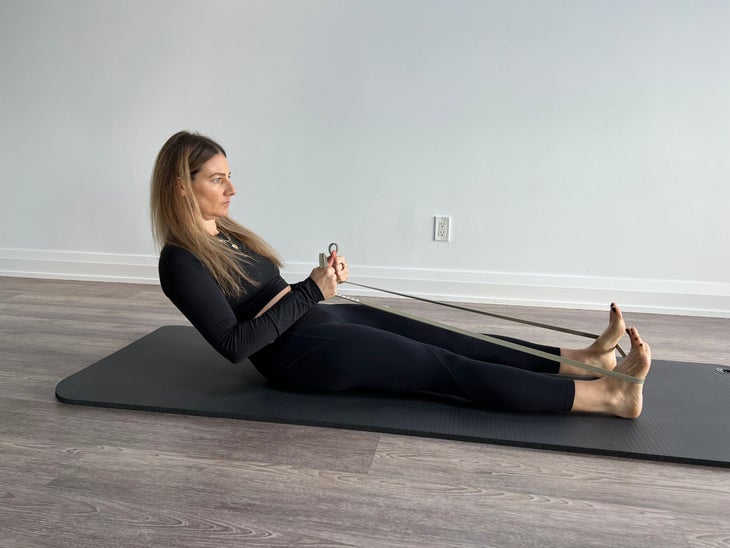
(Photo: Alyssa Ages)
What this move does: Strengthens back and transverse abdominis muscles; helps you stabilize through a full range of motion
How to do it: Sit on a mat and loop a light-to-medium resistance band around the soles of your feet. Extend your legs in front of you and grip the other end of the band with elbows bent and shoulders drawn back. Inhale to engage your core and exhale as you slowly lower your torso back toward the mat, hovering slightly above the floor for a moment before slowly rising back to a seated position. If you start to lose core engagement or stability on the way down, that’s a good stopping point, and you can start to rise back up from there.
Volume: Two sets of 8 to 12 reps, with one minute of rest in between.
5. Dumbbell Windmill

(Photo: Alyssa Ages)
What this move does: Challenges your body through all planes of motion for greater mobility and flexibility; challenges rotational stability; works core (with an emphasis on obliques) and shoulder muscles
How to do it: Stand with feet shoulder-width apart, holding a dumbbell in your left hand. Bring the dumbbell to your left shoulder and then extend your left arm up to raise it directly overhead. Turn your gaze toward the weight and exhale as you slowly slide your right hand down your right leg until you reach your ankle. Then, slowly rise to a standing position. Repeat this movement for all repetitions before switching sides.
Note: You can also do this with a light kettlebell, soup can, or a bottle of water.
Volume: Two sets of 8 to 12 reps per side, with one minute of rest in between.
6. Kettlebell Good Morning
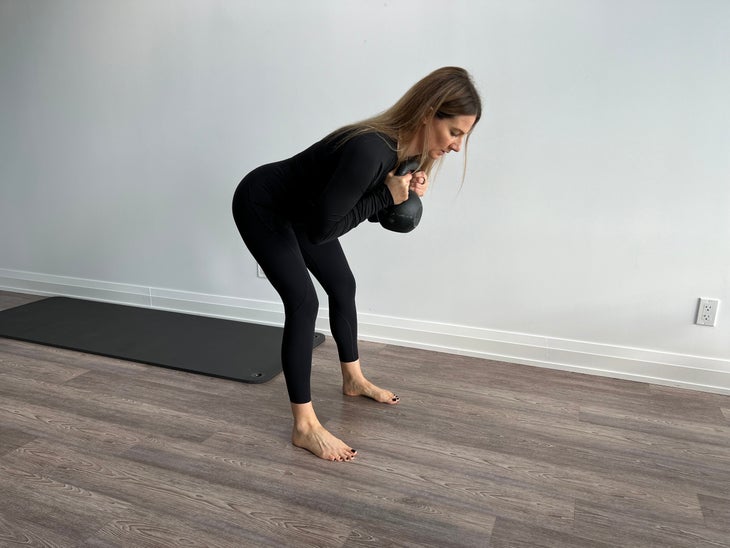
(Photo: Alyssa Ages)
What this move does: Challenges the muscles of the lower back as well as hamstrings and glutes; trains the hip-hinge pattern, which is crucial for lifting heavy things off the ground
How to do it: Grip the handle of a kettlebell with both hands and bring it to chest height. Stand with feet hip-width apart, with a soft bend in the knees. Inhale to engage your core. Keeping a flat back and neck in line with your spine, exhale as you hinge at the hips and send your butt back. Lower your torso as close as you can to parallel with the floor. Pause, then inhale as you slowly rise back up.
Note: You can also use a dumbbell held horizontally or even a jug of water.
Volume: Two sets of 8 to 12 reps, with one minute of rest in between.
7. Kettlebell Single-Leg Romanian Deadlift
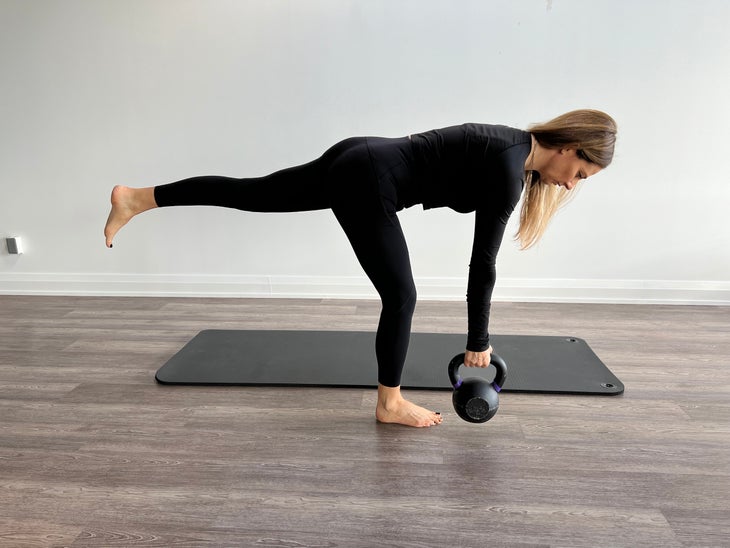
What this move does: Works one limb at a time, which can help identify and correct muscle imbalances; challenges the core as well as the glutes and hamstrings; promotes stability in the standing position
How to do it: Stand with feet hip-width apart, holding a kettlebell in your left hand. Pull your left shoulder back and inhale to brace your core. Allow a slight bend in your right knee and exhale as you slowly hinge at the hips, sending your left leg back behind you with your foot flexed. Your left hand holding the kettlebell lowers toward the floor. Maintain a flat back and neutral neck throughout the movement. Rise back to standing and lightly tap your toes to the ground before repeating the movement. Finish all reps on this side before switching.
Note: You can also do this movement with a dumbbell.
Volume: Two sets of 8 to 12 reps per side, with one minute of rest in between.
8. Dumbbell Russian Twist
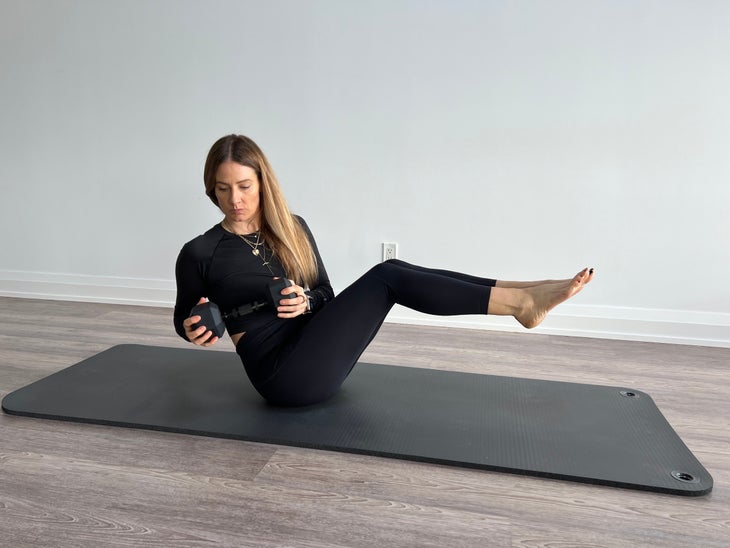
(Photo: Alyssa Ages)
What this move does: Works rotation and anti-rotation patterns; challenges obliques and transverse abdominis
How to do it: Sit on a mat with bent knees and hold a dumbbell at your torso with bent elbows. Inhale to engage your core and hover your feet slightly above the floor. Twist your torso to the right, then back to center, then to the left. That’s one rep.
Volume: Two sets of 8 to 12 reps, with one minute of rest in between.
9. Dumbbell Suitcase Carry

What this move does: Challenges dynamic stability to prepare for carrying uneven loads; works entire core musculature; helps with anti-rotation pattern
How to do it: Hold a heavy dumbbell in one hand and slowly walk the length of the room or gym, trying to avoid leaning or rotating toward the side with the dumbbell. Before turning back, switch the dumbbell to the opposite hand.
Volume: Two sets of 8 to 12 reps per side, with one minute of rest in between.
